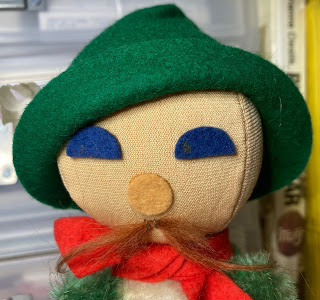"Tis the season for all things green and red! As such, the timing is perfect to share a recent addition to Steiffgal's hug with you. This seasonally hued sweetie is a bit of a mystery but so charming nonetheless. He was on Steiffgal's wish list for awhile given his rarity and somewhat ephemeral construction. Check out this darling doll and see what makes him the perfect 1970s-era ambassador.
Here we have Steiff's little known "Buzzel Sepp." In Germany, "Sepp" is a nickname for someone with the formal name of Joseph. And "Buzzel" refers to his shape and construction. But more about that in just a bit. In all honesty, Steiffgal is not exactly certain who this guy is or who he may represent. He is not obviously a chimney sweep, farmer, or gnome - Steiff's usual cast of male doll suspects. Perhaps he is a shepherd, as he is pictured with a red plastic staff in some reference books. Unfortunately, Steiffgal's Sepp has lost this accessory.
Buzzel Sepp is upright and unjointed. It is not clear if he is standing or sitting as he has no legs. His simple body is made from bright green and white mohair. He rests on a flat bottom. His head is made from a synthetic - probably polyester - fabric. His face comes to life with blue semi-circle felt eyes, a tan circular felt nose, and a long, brown fiber mustache. He is accessorized with a red felt scarf and a green felt hat. His hat has a little daisy on it for decoration. Buzzel Sepp has a working squeaker in his base. This silly guy appeared in the line in this size only from 1972-1974.
It is interesting to note that he is noted in the 1947-2003 Steiff Sortiment as made from dralon but he is clearly made from mohair - at least in this case.
Buzzel Sepp has some distinctive IDs. His chest tag is Steiff's red and yellow split style version. This chest tag debuted in 1972, aligning perfectly with Sepp's production date. On the back of this tag, it is noted that Sepp cost 19.90 marks. Given that $1 = DM 3.48 in 1972, this would have been about $5.72 in 1972 dollars; $5.72 in 1972 is worth approximately $37.85 in 2021. This doll also has a silver hangtag with the word "formgeschaumt" or "foam molded" on it. That refers to his pre-formed foam stuffing. And because he does not have any ears, his ear tag is located on the seam of his bottom with his lentil style Steiff button embedded into it. You can see this somewhat unusual configuration here on the left.
Steiff's Buzzel items appeared in the line in 1970s. They were all 20 cm, sat upon a flat bottom, had a squeaker, were stuffed with pre-formed foam, and washable. Other Buzzel models created included a rooster, a rabbit, a cat, and a Santa Claus, among others. These items - except for Sepp and Santa - were simplified versions of popular Steiff designs. Steiffgal suspects the Buzzels were created specifically as less expensive and/or lower end toy line for children given how the word "washable" featured so prominently in their marketing. And, in Steiff's 1972 product catalog, their Buzzel line is noted as, "foam-molded, therefore super soft, really to love for the very little ones." You can see Sepp and his other Buzzel friends as they appeared in this vintage catalog here on the left. Just click on the image to make it bigger.
Steiffgal hopes this discussion on Steiff's quirky Sepp doll has added a joyful buzz to your day.
Have a question about one of your Steiff treasures? Let's talk! Click here to learn more.





















